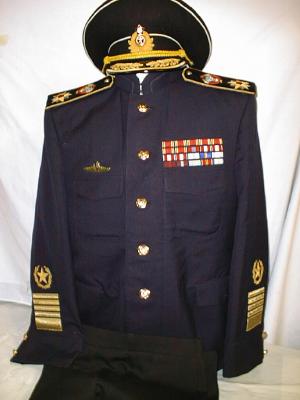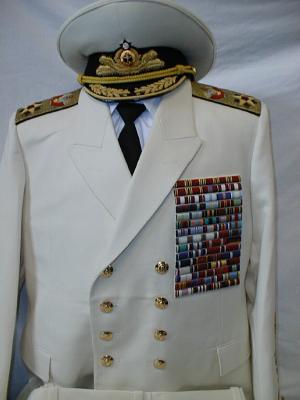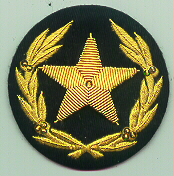| Tell a friend | Print version |
|---|
Admiral of the Fleet, Admiral of the Soviet Union Fleet: History of the Ranks
The history of the military rank of “Admiral of the Fleet” and “Admiral of the Soviet Union Fleet” is rather complicated and intricate. Suffice it to say that these two ranks, in different historical periods, were thought to belong to different land forces ranks; and it was not until 1962 that they were combined into one (heretofore, there was only one naval rank higher than “Admiral” which was equal to Colonel-General).With the establishment of the General and Admiral ranks in 1940, the rank of “Admiral of the Fleet”, which was equal to the land forces rank of “General of the Army”, was introduced, but, unlike the latter one, it was conferred to no one. Up until May 1944, when N.G. Kuznetsov, People’s Commissar of the Navy, and I.S. Isakov, Commander of the Navy Headquarters, were given the rank of Admiral of the Fleet, the highest Navy rank had, practically, been the rank of “Admiral” (1).
Thus, the comparison of the Highest Commanders Ranks in the Army and Navy during 1940-1945 looked as follows:
Marshal of the Soviet Union – (no corresponding rank)
General of the Army – General of the Fleet
Colonel-General – Admiral
Lieutenant-General – Vice-Admiral
Major-General – Rear Admiral
Here is what Nikolay Gerasimovich Kuznetsov, but for whom the rank of “Admiral of the Soviet Union Fleet” would not have appeared, tells about the further history of the ranks of “Admiral of the Fleet” and “Admiral of the Soviet Union Fleet”:
“In 1944 at the General Headquarters, Stalin, to my surprise, brought up a question of my conferring a higher rank. At that time, we did not have any rank higher than the rank of Admiral and, consequently, no corresponding shoulder straps were designed. I reported that other fleets had a rank of Admiral of the Fleet. Then Stalin asked: “What will be its equivalent in our Armed Forces?” I answered that following the order established in the Army, Admiral of the Fleet should be given the four-star shoulder straps; but in this case it would not correspond to the highest rank among the land forces commanders, i.e., the rank of Marshal.
Then it was decided to establish the rank of Admiral of the Fleet with four stars on the shoulder straps without specifying its equivalent in the land forces. So, I was given another rank of Admiral of the Fleet with very unusual shoulder straps which were not typical for the Fleet at all. To tell the truth, I did not wear them long. In May 1944, it was decided to replace these shoulder straps with one-big-star Marshal ones. When the question of compliance with the Army Regulations was discussed, and when the need of specifying the rights and obligations of the Admiral of the Fleet in the Table of Ranks arose, it was written in black and white that the “Admiral of the Soviet Union Fleet” was equal to “Marshal of the Soviet Union”.
Unfortunately, this is not the end of the story. Later (in 1948) I was reduced to the lower rank and had to put on the shoulder straps of Rear Admiral the second time. While being the Pacific Fleet Commander in 1950, I got my next promotion, and after Stalin’s death I was reinstated in my former position, i.e., Admiral of the Soviet Union Fleet (1953). Soon after the War had finished, another actual question arose, namely: Should an Admiral of the Fleet have and wear a Marshal star? As far as I remember, Marshal Zhukov suggested then introducing the new rank name of “Admiral of the Soviet Union Fleet”. The government agreed to ratify this amendment into the highest Navy rank and, subsequently, K.E. Voroshilov, Chairman of the Supreme Soviet Presidium, granted a Marshal star to me and some other admirals. However, my happiness did not last long and soon fortune turned its back on me – I was reduced to the rank of Vice-Admiral. I think that nothing of this kind had ever happened in the history of other fleets. At the very place where I had been given a Marshal star, I had to give it back yet reserving the rank of Vice-Admiral for myself…”
So the chronology of the historical events, described by Kuznetsov, looks as follows: the rank of “Admiral of the Fleet” and four-star shoulder straps were given to Kuznetsov and Isakov on 31 May, 1944 (this rank, as we had already seen, existed in the Navy for 4 years although it was given to no one – at this point the admiral – memorialist is wrong), while the Marshal shoulder straps – on 25 May, 1945; and it was also the date when the rank of “Admiral of the Fleet” was equated to the rank of “Marshal of the Soviet Union”. He was disgraced on 3 February, 1948 and restored to his former rank on 11 May, 1953.
After the rank of “Admiral of the Fleet” was equaled to that of “Marshal of the Soviet Union” in May 1945, a rather unique and ambiguous situation developed: there was no rank in the Fleet that would correspond to the rank of General of the Army any more, that is, two highest fleet ranks belonged not to the one position but to the two positions simultaneously:
Marshal of the Soviet Union – Admiral of the Fleet
General of the Army – (no corresponding rank)
Colonel-General – Admiral
Lieutenant-General – Vice-Admiral
Major-General – Rear Admiral
The military rank of “Admiral of the Soviet Union Fleet” was introduced on 3 March, 1955; at the same time, persons to whom it was granted were told to wear a Marshal star. Basically, it was a renaming of the long-established rank of “Admiral of the Fleet”: the new rank was given precisely to those commanders who had already had the old one, i.e., N.G. Kuznetsov and I.S. Isakov. Addition of the words “Soviet Union” and introduction of the new military insignia of distinction in the form of a Marshal Star were apparently for the purpose of placing an additional emphasis on its equality to the rank of “Marshal of the Soviet Union”. What remained was to make the last logical step in the direction of putting the “vacant” rank of “Admiral of the Fleet” on the same equal footing as the rank of “General of the Army”. This, however, was not done in 1955, and for 7 more years the above-mentioned “distortion” in the soviet Table of Ranks was evident. It was not until 1962 that the rank of “Admiral of the Fleet” was restored and filled the existing gap in the table:
Marshal of the Soviet Union – Admiral of the Soviet Union Fleet
General of the Army – Admiral of the Fleet
Colonel-General – Admiral
Lieutenant-General – Vice-Admiral
Major-General – Rear Admiral
After Kuznetsov’s next demotion (17 February, 1956), Isakov was considered the sole Marshal of the Fleet. Isakov died on 28 October, 1967 and two weeks after his death this rank was given to Sergey Georgievich Gorshkov, Kuznetsov’s successor for the position of the Navy Commander-in-Chief, who bore this rank up to his death in 1988. Since that day, there was no other Admiral of the Soviet Union Fleet in the Navy.
During 1962-1989, the re-established rank of “Admiral of the Fleet” was given many times to the Navy Commander-in-Chiefs (S.G. Gorshkov and his successor V.N. Chernavin), Deputy Commander-in-Chiefs, heads of the Navy Headquarters and some Fleet commanders. Altogether (not counting Kuznetsov, Isakov and Gorshkov), there were 9 military commanders who were granted the rank of “Admiral of the Fleet”.
With the collapse of the Soviet Union, the rank of “Admiral of the Soviet Union Fleet” was abolished. In modern Russian Fleet the highest rank is Admiral of the Fleet (which corresponds to the land forces rank of General of the Army). Thus, the highest ranks in the Army and Navy were equated as it had been in 1940-1945.
During 1962-1997, the Soviet (and later Russian) Admirals of the Fleet used to wear insignia and badges of rank equal to those of Marshals of the Army. Instead of the four-star shoulder straps, a new form of shoulder straps with one big star was designed; while there was a Marshal Star of a “small” size placed on the tie in full dress (parade uniform). The sole purpose of this change in uniform was to overcome the “inequality” between Admirals of the Fleet and rank-equal Marshals of the Army. After the abolition of Marshal of the Army rank in 1993, there was no longer need in specific badges of rank and insignia of the Admiral of the Fleet. In accordance with the Russian President’s decree of 27 January, 1997, Admirals of the Fleet received back the shoulder straps with four stars in a row which had been introduced in 1943-1944, while the Supreme Soviet Presidium’s decree N 4735-Õ “On the Marshal badge of rank and military insignia “Marshal Star”…” of 15 April,1981 was declared invalid in the territory of the Russian Federation.
(1) Prior to “Admiral of the Fleet”, the rank of “Admiral” was given to the following military commanders: L.M. Galler, N.G. Kuznetsov, I.S. Isakov (all since 04.06.1940) and V.F. Tributs and I.S. Yumashev (since 31.05.1943).
Uniform of the Admiral of the Soviet Union Fleet

Full dress shoulder strap of Admiral of the Soviet Union Fleet
Examples of the shoulder straps:

Full dress

Casual to the black double-breasted jacket

Casual to the white double-breasted jacket

Casual service uniform of Admiral of the Soviet Union Fleet

Casual service uniform of Admiral of the Soviet Union Fleet

Full uniform of Admiral of the Soviet Union Fleet

Full uniform of Admiral of the Soviet Union Fleet

Star on the sleeve (to the white double-breasted jacket)

Star on the sleeve (to the black double-breasted jacket)



